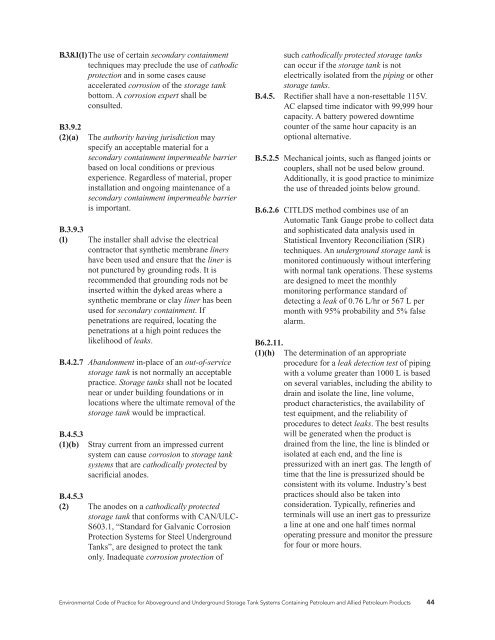Environmental Code of Practice for Aboveground and ... - CCME
Environmental Code of Practice for Aboveground and ... - CCME
Environmental Code of Practice for Aboveground and ... - CCME
Create successful ePaper yourself
Turn your PDF publications into a flip-book with our unique Google optimized e-Paper software.
B.3.8.1(1) The use <strong>of</strong> certain secondary containment<br />
techniques may preclude the use <strong>of</strong> cathodic<br />
protection <strong>and</strong> in some cases cause<br />
accelerated corrosion <strong>of</strong> the storage tank<br />
bottom. A corrosion expert shall be<br />
consulted.<br />
B3.9.2<br />
(2)(a) The authority having jurisdiction may<br />
specify an acceptable material <strong>for</strong> a<br />
secondary containment impermeable barrier<br />
based on local conditions or previous<br />
experience. Regardless <strong>of</strong> material, proper<br />
installation <strong>and</strong> ongoing maintenance <strong>of</strong> a<br />
secondary containment impermeable barrier<br />
is important.<br />
B.3.9.3<br />
(1) The installer shall advise the electrical<br />
contractor that synthetic membrane liners<br />
have been used <strong>and</strong> ensure that the liner is<br />
not punctured by grounding rods. It is<br />
recommended that grounding rods not be<br />
inserted within the dyked areas where a<br />
synthetic membrane or clay liner has been<br />
used <strong>for</strong> secondary containment. If<br />
penetrations are required, locating the<br />
penetrations at a high point reduces the<br />
likelihood <strong>of</strong> leaks.<br />
B.4.2.7 Ab<strong>and</strong>onment in-place <strong>of</strong> an out-<strong>of</strong>-service<br />
storage tank is not normally an acceptable<br />
practice. Storage tanks shall not be located<br />
near or under building foundations or in<br />
locations where the ultimate removal <strong>of</strong> the<br />
storage tank would be impractical.<br />
B.4.5.3<br />
(1)(b) Stray current from an impressed current<br />
system can cause corrosion to storage tank<br />
systems that are cathodically protected by<br />
sacrificial anodes.<br />
B.4.5.3<br />
(2) The anodes on a cathodically protected<br />
storage tank that con<strong>for</strong>ms with CAN/ULC-<br />
S603.1, “St<strong>and</strong>ard <strong>for</strong> Galvanic Corrosion<br />
Protection Systems <strong>for</strong> Steel Underground<br />
Tanks”, are designed to protect the tank<br />
only. Inadequate corrosion protection <strong>of</strong><br />
such cathodically protected storage tanks<br />
can occur if the storage tank is not<br />
electrically isolated from the piping or other<br />
storage tanks.<br />
B.4.5. Rectifier shall have a non-resettable 115V.<br />
AC elapsed time indicator with 99,999 hour<br />
capacity. A battery powered downtime<br />
counter <strong>of</strong> the same hour capacity is an<br />
optional alternative.<br />
B.5.2.5 Mechanical joints, such as flanged joints or<br />
couplers, shall not be used below ground.<br />
Additionally, it is good practice to minimize<br />
the use <strong>of</strong> threaded joints below ground.<br />
B.6.2.6 CITLDS method combines use <strong>of</strong> an<br />
Automatic Tank Gauge probe to collect data<br />
<strong>and</strong> sophisticated data analysis used in<br />
Statistical Inventory Reconciliation (SIR)<br />
techniques. An underground storage tank is<br />
monitored continuously without interfering<br />
with normal tank operations. These systems<br />
are designed to meet the monthly<br />
monitoring per<strong>for</strong>mance st<strong>and</strong>ard <strong>of</strong><br />
detecting a leak <strong>of</strong> 0.76 L/hr or 567 L per<br />
month with 95% probability <strong>and</strong> 5% false<br />
alarm.<br />
B6.2.11.<br />
(1)(h) The determination <strong>of</strong> an appropriate<br />
procedure <strong>for</strong> a leak detection test <strong>of</strong> piping<br />
with a volume greater than 1000 L is based<br />
on several variables, including the ability to<br />
drain <strong>and</strong> isolate the line, line volume,<br />
product characteristics, the availability <strong>of</strong><br />
test equipment, <strong>and</strong> the reliability <strong>of</strong><br />
procedures to detect leaks. The best results<br />
will be generated when the product is<br />
drained from the line, the line is blinded or<br />
isolated at each end, <strong>and</strong> the line is<br />
pressurized with an inert gas. The length <strong>of</strong><br />
time that the line is pressurized should be<br />
consistent with its volume. Industry’s best<br />
practices should also be taken into<br />
consideration. Typically, refineries <strong>and</strong><br />
terminals will use an inert gas to pressurize<br />
a line at one <strong>and</strong> one half times normal<br />
operating pressure <strong>and</strong> monitor the pressure<br />
<strong>for</strong> four or more hours.<br />
<strong>Environmental</strong> <strong>Code</strong> <strong>of</strong> <strong>Practice</strong> <strong>for</strong> <strong>Aboveground</strong> <strong>and</strong> Underground Storage Tank Systems Containing Petroleum <strong>and</strong> Allied Petroleum Products 44

















